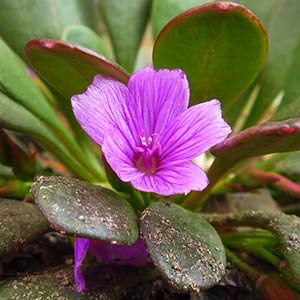Claytonia megarhiza
(synonym of Claytonia megarhiza var. nivalis)
Claytonia multiscapa
alpine springbeauty
lanceleaf springbeauty, Rydberg's spring-beauty
5–25 cm.
10–30 cm.
basal leaves sessile, dilated at base into broad, succulent sheath, blade rhombic to oblanceolate, 2–10 × 0.4–2.8 cm, apex obtuse;
cauline leaves sessile, blade oblanceolate, 2–10 × 2–5 mm.
basal leaves sometimes absent, petiolate, blades linear to narrowly lanceolate, 1–8 × 0.2–1.3 cm, apex acute;
cauline leaves sessile, blade linear or linear-lanceolate, 2–10 cm, distinctly tapered.
multibracteate;
bracts subtending pedicels, apex obtuse.
multibracteate;
proximalmost bracts leaflike, inserted proximal to pedicels of proximalmost cluster of flowers, distal bracts reduced to membranous scales, rarely with 1 bract.
12–20 mm diam;
sepals 6–8 mm;
petals white, pink, or rose, 5–20 × 3–8 mm;
ovules 6.
8–14 mm diam.;
sepals 3–5 mm;
petals white with yellow spots at base, creamy white, or rich yellow to yellow-orange, 8–10 mm;
ovules 6.
2–3 mm diam., shiny and smooth;
elaiosome 1 mm or less.
1–2 mm diam., shiny and smooth to minutely tuberculate;
elaiosome 1 mm or less.
= 12, 16, 24, 32, 34, 36.
= 16.
Claytonia megarhiza
Claytonia multiscapa
Claytonia multiscapa has been the source of taxonomic differences of opinion. Local floras have treated the synonymous C. flava as a distinct species (e.g., R. D. Dorn 1977) while one regional flora (C. L. Hitchcock et al. 1955–1969, vol. 2) united it with C. lanceolata. It is treated here as a distinct species based on the electrophoretic and field work of J. S. Shelly (1998) and the author’s examination of type material.
(Discussion copyrighted by Flora of North America; reprinted with permission.)
- Local floras:
BC,
CA,
OR,
WA
- Local Web sites:
CalFlora,
CalPhotos,
Flora NW,
PNW Herbaria,
SW CO Wildflowers
WildflowerSearch
iNaturalist (observations)
USDA Plants Database
- LBJ Wildflower Center
- SEINet
- Plants of the World Online
- Encyclopedia of Life
- Wikipedia
- Google Image Search


